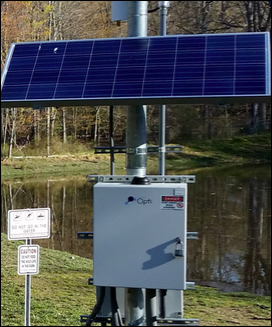Stormwater is currently ravaging Louisiana, where flooding has killed at least eight residents and left 20,000 people in need of rescue. While the type of huge downpour that caused this flooding is becoming more common, even far less extreme weather events take a toll on cities and towns all over the country, by exceeding the capacity of stormwater storage systems and thereby contributing to the degradation of the public infrastructure. That is especially true in the more than 750 U.S. cities with combined stormwater and sewage systems, where storms can force untreated sewage into public waterways, which can result in eutrophication and odor and inflict major environmental and economic costs, such as the lowering of property values near sites where overflows occur frequently. When the capacity of a city or town’s stormwater infrastructure is surpassed, this can also harm roadways and cause localized flooding in homes or commercial buildings.
Opti, a Boston-based technology provider that spun out from environmental management firm Geosyntec Consultants in 2014, uses IoT technology to help water managers—municipalities, utilities, contractors hired by municipalities, or large organizations such as corporations or universities—to better manage their stormwater storage systems and reduce infrastructure spending related to stormwater.
Opti remotely manages stormwater control systems deployed at 130 customer locations around the country. It mounts a either a pressure transducer or an ultrasonic level sensor on each stormwater storage tank or retaining pond, and the device uses the Modbus protocol to communicate, via a serial cabled connection, to a controller box that is linked to an actuator that controls the tank’s release valve. Opti mounts a cellular communications module to the controller, as well.
The company uses this hardware to power its OptiNimbus product offering, designed specifically for improving stormwater management (it also sells predictive maintenance and environmental-monitoring services). OptiNimbus uses proprietary algorithms to analyze the water-level data along with weather forecasts in order to optimize the rate and timing of stormwater to be released from storage tanks. The OptiNimbus software then communicates with the controller at the storage tank, via Particle’s cloud-based interface, to manage stormwater storage levels remotely, by releasing overflow in a controlled manner to reduce flooding and limit downstream impacts.
Doing so helps water managers lower the cost and risk of managing stormwater, according to Alex Bedig, Opti’s VP of Information and Technology, who says Opti can also “model regulatory benefits” by evaluating their customer’s investment in stormwater infrastructure against risks and costs related to potential Clean Water Act violations in the event of overflows.
Opti also helps customers who are planning for new construction—say, a housing subdivision—to create models for stormwater flow and capacities in order to ensure that they create an adequately sized storage pond. In some cases, he says, Opti saves customers money by finding that they don’t need to build a pond that is as large as first estimated.
Opti’s principals first developed the IoT technology in 2009, when they worked for Geosyntec Consultants, and at that time they contracted Massachusetts-based IoT connectivity provider ioBridge to provide the cellular modems that linked sensor modules to their cloud-based platform. But a management change at ioBridge led to Opti needing to quickly find a new connectivity provider. In January, it started working with Particle (formerly Spark.io), a provider of cellular and Wi-Fi based communications modules and connectivity services, to transition its connectivity layer.
“Our goal is to make it easier to build connected products,” says Particle’s CEO and co-founder, Zach Supalla. “We enable customers to get products to market quickly and to help them from getting stuck in early stages of development.” Particle handles the SIM card provisioning, data plans and communication device management functions, which are managed through Particle’s cloud-based platform, used to publish data, events, and alerts securely to the customer (or, in this case, Opti). The Particle Cloud is also used to push over-the-air firmware updates to the Opti hardware to which the Particle communication module is mounted.
Thus far, Particle’s Electron cellular module and Photon Wi-Fi module have been installed or are being installed at around 40 of Opti’s customer locations. (The Photon modules are used only in deployments with underground stormwater storage tanks, where the modules along with a Wi-Fi access point with a cellular backhaul, are used to monitor levels of those aboveground tanks.)
The hardware uses line power, where available. In remote locations that lack electricity, the hardware is powered by a solar panel and rechargeable batteries.
Particle’s Supalla says there are two integral parts to an IoT project—the business logic platform, which includes the application software and tools for managing and analyzing data; and the connectivity layer, which is needed for device management and to ensure a fleet of physical devices can “talk securely to the web.” Most IoT vendors want to handle the business logic platform, “because that is where the value is created.” But, he says, device management, which Particle provides, is vital because it provides the critical link to remote access. “It’s where the largest technical risks are,” he says.
The business partnership is arranged such that Opti pays Particle a monthly fee based on the number of events transmitted between a sensor module and the cloud, as well as the quantity of data transmitted. Opti then incorporates these costs into the periodic service fees it charges its customers.



